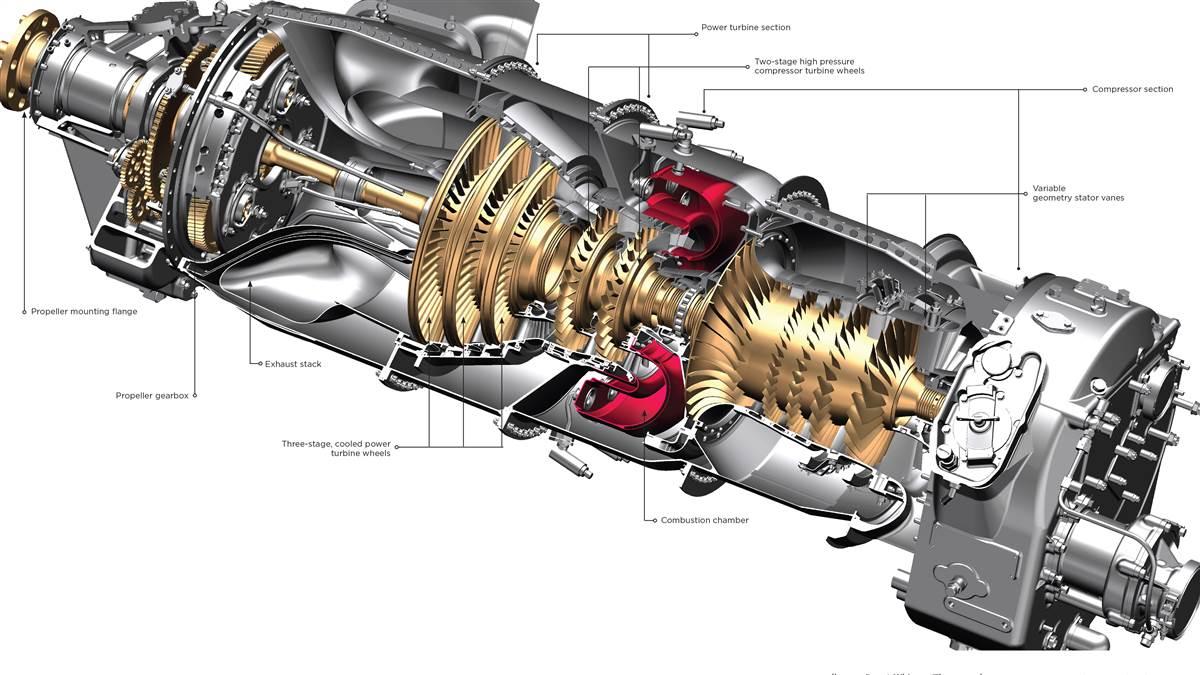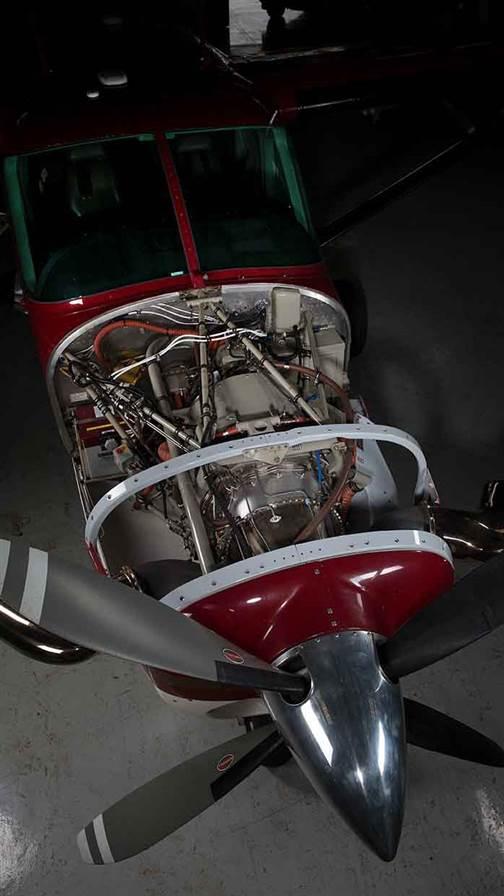Free-turbine faceoff
With Cessna’s Denali, it’s a new day in the turboprop world

 Its reputation carried through on the company’s early corporate logo, which consists of an eagle within a circle inscribed with the slogan “Pratt & Whitney—Dependable Engines.” What passenger wouldn’t feel reassured looking out the window and seeing that slogan? (More recent logos have featured a stylized eagle, rinsed of character and sloganry, followed by an even less inspiring circular design with the rousing proclamation that it’s a “United Technologies Company.”)
Its reputation carried through on the company’s early corporate logo, which consists of an eagle within a circle inscribed with the slogan “Pratt & Whitney—Dependable Engines.” What passenger wouldn’t feel reassured looking out the window and seeing that slogan? (More recent logos have featured a stylized eagle, rinsed of character and sloganry, followed by an even less inspiring circular design with the rousing proclamation that it’s a “United Technologies Company.”)
There are good reasons why the PT6A design is a success. Far simpler than the large radial engines it was built to replace, the engine has a high power-to-weight ratio, for one thing. Its reverse-flow, free-turbine arrangement is even more significant.
Reverse-flow, free-turbine in brief
At first, the reverse-flow concept sounds odd. Instead of intake air entering the front of the engine and exhaust being expelled from the rear, the flow is just the opposite. Air enters the rear of the engine and is forced forward, while exhaust goes out near the front.
Let’s take a quick trip with this flow to better understand the engine’s workings. It all starts with air entering an intake at the front of the engine nacelle, then passing along a duct and through an intake screen at the aft end of the engine. The duct has an inertial separator door that shunts dirt and other damaging foreign objects out of the intake stream, and the screen prevents larger debris from being sucked into the engine core.
Once air enters the engine it passes through a compressor section, consisting of a series of compressor wheels that compress and heat the incoming air—which then mixes with fuel, injected through nozzles, and is ignited in the combustion chamber.
Next, the heated gas from the combustion chamber is forced into the power turbine section of the engine, which, when it spools up, can reach 30,000 rpm. The power turbine section’s wheels are on a drive shaft connected to the propeller gearbox. It’s the gearbox’s job to convert those 30,000 rpm into an output speed of some 2,000 rpm—depending on the propeller governor—which obviously is a much more practical, usable speed for a propeller.
In 2015, GE contracted to build a clean-sheet engine design for the upcoming Cessna Denali single-engine turboprop. It was a full-frontal challenge to Pratt & Whitney.So why is the design called “free-turbine”? Because the compressor and power turbine shafts are not connected. They turn independently of each other. There’s no single shaft running the entire length of the powertrain—which is a design feature of the single-shaft Garrett/Honeywell turboprop engine. (But that’s a story for another day.)
Those separate shafts are but one of the reverse-flow, free-turbine design’s advantages. When you start the engine, you only need to turn the compressor shaft to get things going. That means less load on the starter, and faster starts. Two independent shafts also mean shorter shafts, ones that aren’t subject to the heat-induced “shaft bowing” that affects single-shaft designs after shutdown. The reverse-flow arrangement lessens the chance of foreign object damage to the engine. And having the power section at the front of the engine means that maintenance can be done “on wing,” and won’t involve removing the entire engine.
Another advantage is the scalability of the design. PT6As can be built in different sizes and power ranges, yet retain the same core design concepts.
General Electric’s Advanced Turboprop (ATP) design
Pratt & Whitney isn’t the only manufacturer of reverse-flow, free-turbine turboprop engines. General Electric’s Business and General Aviation division has been building engines since 1963, when it provided its CJ610 turbojet engine for the Lear 23. In 2008, GE expanded its offerings with the acquisition of the Walter Aircraft Engines’ line of Czech-built turboprop engines. Out of that came an ambitious project to refine the basic Walter M601 engine into a more modern product. The result was the H series of turboprop engines, one of which—the H75-100 engine—is now installed in Nextant Aerospace’s G90XT conversion of Beechcraft’s King Air C90A.
In 2015, GE upped the ante by contracting to build a clean-sheet engine design for Textron Aviation’s upcoming Cessna Denali single-engine turboprop. It was a full-frontal challenge to Pratt & Whitney. “They wanted a more modern alternative than what was already on the market,” said Mike Brands, GE’s senior product leader for turboprops.
For GE, that meant a reverse-flow, free-turbine design of 1,240 shaft horsepower, optimized for 10 percent more cruise power than a similarly-sized PT6A; a 20-percent lower fuel burn; lower emissions; lighter weight; a single-lever power control; and dual channel, full authority digital engine control (FADEC).
The ATP’s fuel efficiency comes from the compressor section’s increased pressure delivery to the combustion chamber. In addition, four new, computer-designed compressor blades and wheels, plus variable stator vanes between the wheels, optimize the swirl of the airflow. This, plus the compressor’s two-stage high-pressure turbine assembly, creates two important actions, according to Brands. “The extra high-pressure turbine wheel sends hotter air into the combustor, which in turn delivers more energy to the power turbine section’s three wheels, and also makes for more complete combustion, more power per unit of fuel, and lower emissions,” Brands said. “And it also sends cooler air via internal passages that bypasses the combustor.” This cooler air is then sent to the power turbine blades, which are hollow and allow air to enter and exit them.
The result is a process that offsets the extra heat of combustion by cooling the power turbine blades—and thus lets the ATP engine have a longer, 4,000-hour recommended time between overhauls.
Yet another innovation is the ATP engine’s use of 3-D printing. This process lets GE use robotics to “grow” a computer-designed part by depositing metal—an additive process that uses direct metal laser melting—rather than the conventional method of machining a part from a billet. This allows complicated parts assemblies with, say, ducts and other parts with metal-within-metal elements to be made as a single part. Good examples are the ATP’s combustor liners and heat exchangers, which are comprised of complicated fins and tubes. Ordinarily, welding and brazing of many parts would be required, which means many seams and seals. With 3-D additive techniques, these are made as single, seamless parts.
This reduces weight and parts count. “By using additive methods, we’ve taken what would have been 855 parts using traditional manufacturing, and reduced the parts count to just 12,” Brand said. Some 35 percent of the engine is built with additive parts.
The FADEC engine controls are being made under a joint venture between GE and one of its European suppliers. Using FADEC, engine start procedures are reduced to a single button-push; engine speed, engine temperatures, and propeller governing are automatically controlled so no limits are exceeded. To set power, the pilot simply advances the power lever to click stops for takeoff, cruise, and idle power, and the FADEC’s sensors automatically set the optimal engine parameters for the environmental conditions at hand—altitude, temperature, pressure, and so on. It’s a great safety and workload-saving tool and, like the extra high-pressure compressor and (cooled) power turbine wheels, it’s something that GE says PT6As of the same power range do not have.
The ATP is in the test phase now, with first engine runs meeting targets. Flight tests will come later in 2018, and certification of the $4.8 million, 285-knot, 1,600-nm Cessna Denali is expected in 2019. By that time, we’ll have a closer look at this airplane’s new engine, Garmin G3000 avionics, and other features in action. Here’s guessing that we’ll also hear Pratt & Whitney’s answer to the ATP by then.
Email [email protected]



